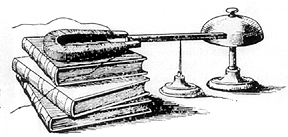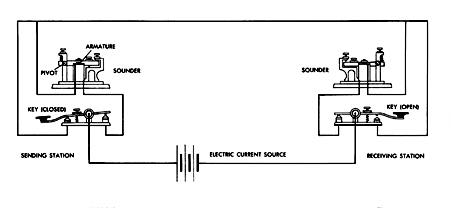
phone
cards
all you need to know about
 |
|
phone | |
all you need to know about | |||
Telephone History Series
by Tom FarleyPage 2 >> 1830 to 1870
In a stunning demonstration in his Albany Academy classroom, Henry created the forerunner of the telegraph. In the demonstration, Henry first built an electromagnet by winding an iron bar with several feet of wire. A pivot mounted steel bar sat next to the magnet. A bell, in turn, stood next to the bar. From the electromagnet Henry strung a mile of wire around the inside of the classroom. He completed the circuit by connecting the ends of the wires at a battery. Guess what happened? The steel bar swung toward the magnet, of course, striking the bell at the same time. Breaking the connection released the bar and it was free to strike again. And while Henry did not pursue electrical signaling, he did help someone who did. And that man was Samuel Finley Breese Morse. 
As depicted below, his system used a key (a switch) to make or break the electrical circuit, a battery to produce power, a single line joining one telegraph station to another and an electromagnetic receiver or sounder that upon being turned on and off, produced a clicking noise. He completed the package by devising the Morse code system of dots and dashes. A quick key tap broke the circuit momentarily, transmitting a short pulse to a distant sounder, interpreted by an operator as a dot. A more lengthy break produced a dash. Telegraphy became big business as it replaced messengers, the Pony Express, clipper ships and every other slow paced means of communicating. The fact that service was limited to Western Union offices or large firms seemed hardly a problem. After all, communicating over long distances instantly was otherwise impossible. Yet as the telegraph was perfected, man's thoughts turned to speech over a wire.  In 1854 Charles Bourseul wrote about transmitting speech electrically in a well circulated article. In that important paper, the Belgian-born French inventor and engineer described a flexible disk that would make and break an electrical connection to reproduce sound. Bourseul never built an instrument or pursued his ideas further. In 1861 Johann Phillip Reis completed the first non-working telephone. Tantalizingly close to reproducing speech, Reis's instrument conveyed certain sounds, poorly, but no more than that. A German physicist and school teacher, Reis's ingenuity was unquestioned. His transmitter and receiver used a cork, a knitting needle, a sausage skin, and a piece of platinum to transmit bits of music and certain other sounds. But intelligible speech could not be reproduced. The problem was simple, minute, and at the same time monumental. His telephone relied on its transmitter's diaphragm making and breaking contact with the electrical circuit, just as Bourseul suggested, and just as the telegraph worked. This approach, however, was completely wrong. Reproducing speech practically relies on the transmitter making continuous contact with the electrical circuit. A transmitter varies the electrical current depending on how much acoustic pressure it gets. Turning the current off and on like a telegraph cannot begin to duplicate speech since speech, once flowing, is a fluctuating wave of continuous character; it is not a collection of off and on again pulses. The Reis instrument, in fact, worked only when sounds were so soft that the contact connecting the transmitter to the circuit remained unbroken. Speech may have traveled first over a Reis telephone however, it would have done so accidentally and against every principle he thought would make it work. And although accidental discovery is the stuff of invention, Reis did not realize his mistake, did not understand the principle behind voice transmission, did not develop his instrument further, nor did he ever claim to have invented the telephone. 
In the early 1870s the world still did not have a working telephone. Inventors focused on telegraph improvements since these had a waiting market. A good, patentable idea might make an inventor millions. Developing a telephone, on the other hand, had no immediate market, if one at all. Elisha Gray, Alexander Graham Bell, as well as many others, were instead trying to develop a multiplexing telegraph -- a device to send several messages over one wire at once. Such an instrument would greatly increase traffic without the telegraph company having to build more lines. As it turned out, for both men, the desire to invent one thing turned into a race to invent something altogether different. And that is truly the story of invention.
|